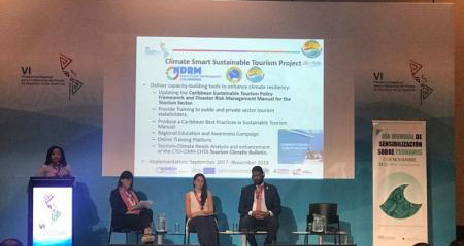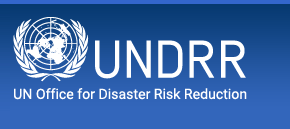- Our Mandate
- Mission and Objectives
- UNDRR in the UN
- Work Programme & Annual Reports
- Results Based System
- Work Partnerships
- Headquarters - Geneva
- SG-UN representatives for DRR
- Regional Office – The Americas and the Caribbean
- Head of the Regional Office – The Americas and the Caribbean
- What is Disaster Risk Reduction?
- What is the International Strategy?
- History of UNDRR
Tourism industry in Americas, Caribbean prepares against tsunami risk
 Participants at a workshop on climate smart tourism at the Regional Platform for Disaster Risk Reduction in Cartagena
Participants at a workshop on climate smart tourism at the Regional Platform for Disaster Risk Reduction in Cartagena
CARTAGENA, 26 June 2018 – Tsunamis may be rare in the Americas but they do happen as the region is highly seismic prone. A dozen earthquakes of magnitude 7.0 or greater have occurred in the Caribbean near Puerto Rico, the Virgin Islands, and Hispaniola in the past 500 years generating more than 75 tsunamis.
"We do see a general increased tsunami awareness now as the tourism sector and governments are starting to feel more vulnerable to weather related disasters," said Amanda Charles, from the Caribbean Tourism Organization (CTO) at a session on how to reduce tsunami risk in the tourism sector held at the Sixth Regional Platform for Disaster Risk Reduction in Cartagena, Colombia last Friday.
"The tourism sector is realizing how much they can lose when disasters happen. Some are also beginning to understand that resilience can be an additional competitive advantage as well," added Charles.
Last year, more than 30 million tourists visited the Caribbean which contributed more than $37 billion to the Caribbean economy, according to the CTO, a record breaking year for the Caribbean region despite the devastating 2017 hurricane season.
"Countries such as Anguilla and the four islands of British Virgin Islands are now Tsunami ready. St. Kitts and Nevis have annual drills, inundation and tsunami evacuation maps and Puerto Rico has developed a tsunami safety card for tourists which is accessible and distributed in hotels.
"Those are considerable progresses even if we can still see some resistance from countries too cautious to scare tourists and with too many assets located in areas vulnerable to tsunamis," Charles said.
The Dominican Republic is among the few Islands to have integrated tsunami risks in its local prevention plans.
"In 1946, we faced a tsunami following a magnitude-8.1 earthquake off the northeast coast which killed more than 1,600 people and we learned the lesson," said Pedro Reynado Santana Martede from the Civil Defense of the Ozama region and representative of the municipality of Santo Domingo Este, a city of nearly 900,000 people, committed to UNDRR's Making City Resilient Campaign.
"The problem is really at community level and this is where we are focusing our major work, so coastal populations will know what to do if they observe the first signs of a tsunami." said Martede.
With more than 4,300 km facing the Pacific Ocean, Chile is extremely exposed to the threat of tsunamis, with no fewer than four events in the past ten years. The 8.8 quake that hit central Chile in 2010 killed more than 500 people and cost more than $30 billion, most damage was related to infrastructure.
"We have considerably improved our national monitoring and warning and invested massively in structural and non-structural preventive measures to reduce economic losses," said Barnadita Paul, currently dealing with the Reconstruction and risk management of disasters at the Ministry of Housing and Urban Development in Chile, and a counsellor in Puente Alto.
"The tourism sector is very aware of the cost benefit of investing in disaster risk reduction measures and risk assessments before building new infrastructure and I am quite confident that we are making progress."
Reducing disaster impacts and achieving target "c" of the Sendai Framework – the world plan for reducing disaster losses by 2030 – was a central theme at the Regional Platform for Disaster Risk Reduction, in Colombia last week, and among the main commitments made by Americas in the final Cartagena declaration.
Linked to this, "Reducing economic losses" will also be the theme of this year's Tsunami Awareness Day, marked each year on 5 November.
The region is the second most disaster-prone in the world after Asia-Pacific with an estimated $300 billion losses in 2017 including the Mexican earthquakes.
Related links
Sendai Framework for Disaster Risk Reduction
The 6th Regional Platform for Disaster Risk Reduction in the Americas
Follow the UNDRR news online :
 Now we have twitter account @UNDRR Américas y el Caribe
Now we have twitter account @UNDRR Américas y el Caribe
JOIN US!
Tweets por el @UNDRR Américas y el Caribe
